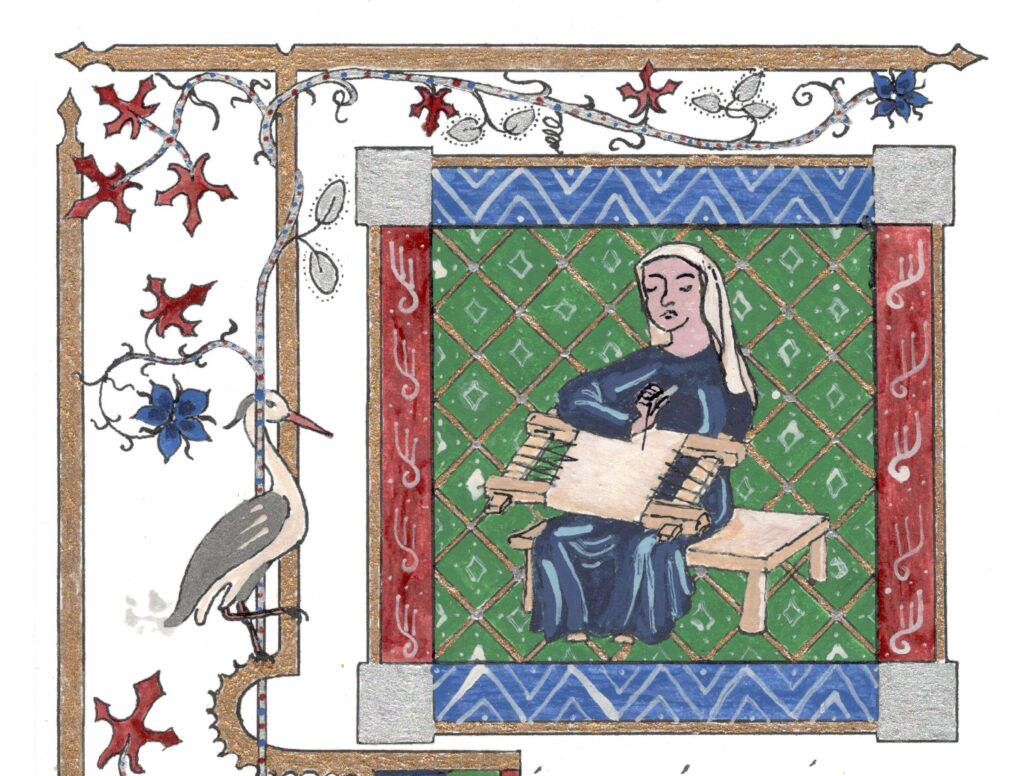In the 80s, we had an art historian in the Netherlands who started to systematically trawl through historical records to find late medieval and early modern embroiderers and embroidery guilds. She published a couple of great articles on the topic. However, the large overview publication she promised in her 1987 article never saw the light of day. Instead, Prof. Dr. Saskia de Bodt switched to studying illustration. And although I am sure she has a lovely and fulfilling career, I am sad she switched topics! And I am wondering in what state this promised ‘large overview publication’ is? I did contact her, but never received an answer. In the meantime, I am grateful for the work she did! And I love sharing these somewhat obscure Dutch publications with you.

In the Low Countries, the embroiderers were never organised in their own embroidery guilds in the medieval period. Could this be because there were rarely enough embroiderers in a particular city in the medieval period to make this worthwhile? Unfortunately, we have very limited sources for the late medieval period. But this seems to be a plausible explanation. So, how did they organise themselves? One thing most cities seem to have in common is that the embroiderers have been organised in one way or another since the late 15th century. Precisely the time when embroidery really takes off in the Low Countries. However, things usually become official much later.
But there are exceptions. Especially in the South (nowadays Belgium). For instance, embroiderers are mentioned as part of the guild of the tailors and doublet makers in AD 1403 in Ghent. Bruges follows in AD 1441. Again, embroiderers are part of a guild together with the quilters and doublet makers. In Antwerp, the embroiderers were among the initiators of the Saint Luke Guild in AD 1382. The Saint Luke Guild is a common guild for many different kinds of artists. The Antwerp Guild united painters, gold and silver smiths, glaziers and wood carvers.
The embroiderers in Amsterdam first belong to the Our Lady Guild of Masons. This guild was formed in the second half of the 15th century. Don’t be fooled by the name. Painters, glaziers and other artisans were also part of this masons’ guild. In the course of the 16th century, the embroiderers and the other artisans separated to form the Saint Luke guild. The embroiderers of Haarlem belong to the Saint Luke guild from its formation sometime during the late 15th century. Things become official in AD 1514. I found it shocking to read that after the reorganisation of the guild in AD 1631, the embroiderers belonged to the lowest rank of artisans represented by the guild. The painters were the top dogs, of course.
Other cities where the embroiderers belonged to the Saint Luke guild are: Dordrecht, Kampen, Gouda, Rotterdam, Delft, Middelburg, Vlissingen, Veere, Nijmegen, Zwolle, Den Bosch, Bergen op Zoom and Venlo. Why were the embroiderers part of a guild that was or at least became increasingly dominated by the painters? One reason might be that this is how they acquire their patterns. Another is that in sources written in Latin, their profession is named acupictores or painter with a needle. It thus seems that medieval people in the Low Countries (especially in the North) did see embroiderers as painters and not so much as textile workers.
But again, we have some exceptions. In Groningen, the embroiderers were part of the peddlers’ guild, together with the passementerie workers. In Utrecht and Rhenen, the embroiderers were part of the tailors’ guild. And in Arnhem, they essentially called the Saint Luke Guild the Saint Josef Guild.
And you would probably think that the embroiderers would be well off within the tailors’ guild. After all, the embroiderer makes the orphreys that the tailor then attaches to the vestment he has cut and put together. Good relations between embroiderers and tailors are thus important. And they probably were amicable as long as the job was high-end and complicated. But things became muddled when the job required ‘simple’ embroidery or ‘simple’ sewing. For instance, when vestments were mended. This overlap was the centre of much dismay and legal action between the two professions.
I hope you’ve enjoyed learning a bit more about the organisation of medieval embroiderers and embroidery guilds in the Low Countries. My Journeyman and Master Patrons will have access to an English translation of the chapter by Saskia the Bodt on which this blog is based. It contains a wealth of information and a bibliography for further research.
Literature
Bodt, S. de, 1987. De professionele borduurwerkers, in: Bodt, S. de, Caron, M.L. (Eds.), Schilderen met gouddraad en zijde. Rijksmuseum Het Catharijneconvent, Utrecht, pp. 8–19.
